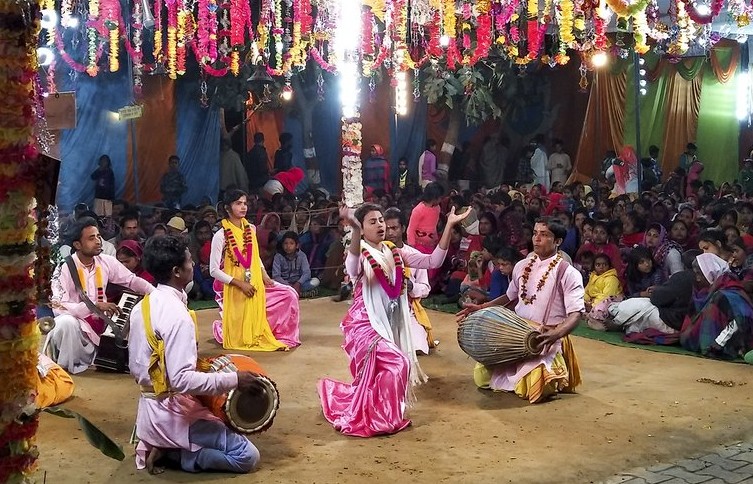“Śrīla Prabhupāda’s Kīrtana Standards,” installment 6
Instructions from Śrīla Prabhupāda

Śrīla Prabhupāda instructed, “We should not try to make a profit out of the Hare Krishna Mantra; then our spiritual enlightenment will be hampered.”1 And so: “One should not make a livelihood by forming a professional band to carry out congregational chanting.”2
Śrīla Prabhupāda sometimes suggested having kīrtana performances for which tickets would be sold,3 and from his earliest days in New York City, when he was living on the Bowery, before moving to 26 2nd Avenue, he would take up a collection at the end of his kīrtana and class.4 But in both cases the income was always meant for preaching, not for profit or family maintenance.
In 1967 Śrīla Prabhupāda wrote to Jadurānī Dāsī:
I understand also, there was a Kirtana performance given by Sri Purna das. You have rightly remarked whether they are devotees. You are right. These people are professional singers. Krishna Kirtana is not for earning livelihood. Krishna Kirtana is not meant for entertaining the public for demonstration of arts. It is dynamic service to the Lord. We do not therefore mind so much about the artistic presentation of Krishna Kirtana but we want to see how much a devotee is satisfying the Supreme Will.5
Instructions from predecessor ācāryas
Śrīla Bhaktisiddhānta Sarasvatī Ṭhākura said that professional bhajana singers are chanting not Hare Kṛṣṇa but “money money.”6
And a generation earlier, Śrīla Bhaktivinoda Ṭhākura wrote about making a living by doing kīrtana door to door:
There are many ways to make a living; it is one’s duty to engage in some activity to do that. If villagers voluntarily give some alms after hearing the Name of Hari, it is not wrong to accept that. But it is very unjust and opposed to bhakti to collect money by selling hari-nāma, considering it to be a livelihood. By doing this, both the giver of the Name and the listener will never have the possibility of obtaining the result of prema, and only pāpa [sin] will be accumulated. Hari-nāma cannot be bought with money, the only price is śraddhā. Thus, it is advised that everyone should hear and chant with śraddhā.7
As Śrīla Bhaktivinoda Ṭhākura said, devotees may travel about and do kīrtana, and when people volutarily give some contribution in charity the kīrtanīyas may accept it. In fact, householders should give charity.8 But one should not do kīrtana to gain a profit or make a living. Kīrtana should not be a business.
This is an installment of a draft for an upcoming book.
I especially welcome comments—suggestions, criticisms, questions, whatever.
Among other things: If you were personally present with Srila Prabhupada and received or heard instructions from him about kirtana, or were present at an instructive incident, I’m all ears.
I’m also particularly interested in hearing from “second generation” devotees (or third generation)—those born into the Hare Krishna movement or who joined after Srila Prabhupada’s departure. Again, I’m all ears.
Especially welcome: Thoughts or evidence that runs contrary to what’s in the draft or that adds a different perspective or nuance.
The draft has not yet been reviewed for spelling, italics, diacritic marks, and so on. I’ll handle that later. The same goes for formatting—headlines, subheads, and the like. For now, what matters is the content.
You can reach me by the contact form on this site. Or if you have my contact details, feel free to call me, message me, or send me an email.
Thank you very much. And happy chanting!
Notes
- Letter to Mukunda, July 2, 1969[↩]
- Caitanya-caritāmṛta, Madhya 8.83, purport.[↩]
- For example, see his letters to Haṁsadūta dated January 22 and February 4, 1968.[↩]
- Śrīla Prabhupāda records this multiple times in his diary from those days. See The Beginning: The 1966 New York Journal.[↩]
- Letter to Jadurānī, December 12, 1967. In The Art of Spiritual Life (p. 103‒4) Jadurānī recounts the circumstances that led to the letter. Satsvarūpa Dāsa Goswāmī also describes them, along with his realizations about the letter, in Prabhupāda-līlā, Chapter 2, December 1967.[↩]
- Bhakti Vikāsa Swami, “Kirtana,” p. 29[↩]
- Ṭahala, article published in Sajjana Toṣanī, 1896. For the full article, see Appendix 1. And it’s available here.[↩]
- yajño dānaṁ tapaś caiva pāvanāni manīṣiṇām, Gītā 18.5.[↩]

You must be logged in to post a comment.